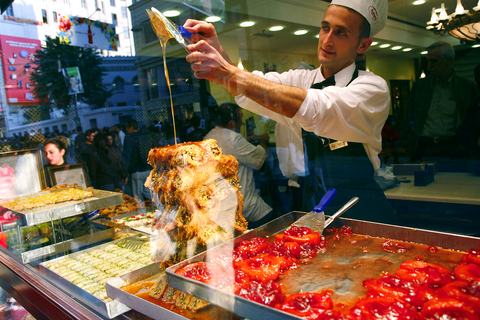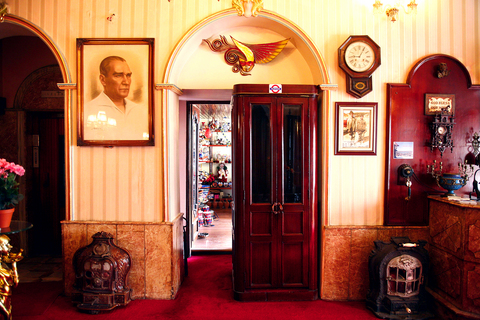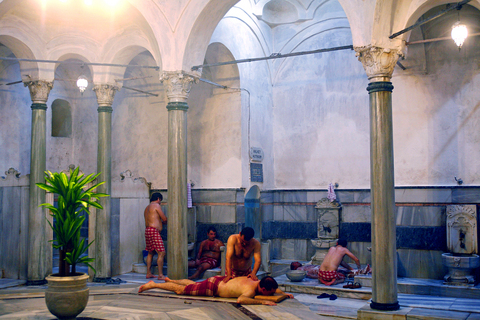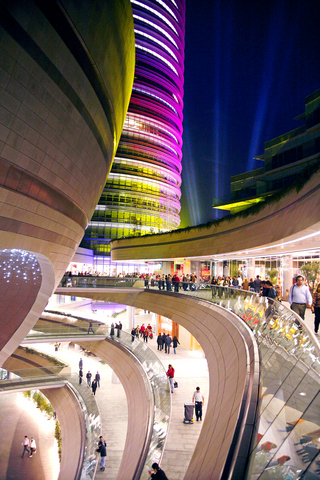"One million lira," piped the cashier at the cybercafe. And for the one-millionth time since arriving in Istanbul, I did a double take. How could a few minutes online add up to such a staggering figure? And how, on a budget of just US$500, was I going to make it through the weekend?
The cashier was invoking, as many Turks still do, the old Turkish currency instead of the new, which was introduced last year and lopped six zeroes off everyone's bills.
The cybercafe bill (which was only US$0.65 cents at the exchange rate then) was yet another reminder that Turkey and, especially, Istanbul are places that casually, if not always effortlessly, blend the old and new, the East and West, the secular and the spiritual. That jumble of identities may be a cliche, but over the course of a late-June weekend in Istanbul, it was a cliche the city never let me forget, not even for a minute.

PHOTOS: NY TIMES NEWS SERVICE
Take my lodging: the Grand Hotel de Londres, built in 1892 to accommodate the waves of European tourists arriving via the Orient Express. Over the last 114 years, its fortunes have waxed (Hemingway stayed here in 1922) and waned (when chains like Hilton arrived in the 1950s). But today it's newly worthy of its adjective, with thick red carpets, ornate chandeliers, a staff that appears to care about the guests and an antiques-filled lobby that broadcasts WiFi throughout the lower floors.
My big renovated room was furnished with dark wood and gilt molding. I drew aside the curtains and found a wide balcony looking out on the steely waters of the Bosporus and, across the strait, dozens of mosques dotting the hills of Uskudar.
And it was cheap. The renovated rooms started at US$75 a night, with a 10 percent discount for paying cash. Even better (for me), Turkey was going through summertime economic woes that strengthened the dollar to 1.55 lira. (It was 1.50 lira on Nov. 1.)

Still, I wasn't sure how large my other expenses would be, what with Turkey wending its way toward European Union membership and Newsweek's 2005 cover story about "Cool Istanbul." Could I live like a sultan on 565 new lira?
Luckily, I had my own personal vizier: Elif, a friend of a woman I'd met in Malaysia, who turned out to be the personification of Istanbul — equal parts tradition and modernity. An energetic, hyper-intellectual woman in her early 30s, Elif is a serious Muslim yet has a healthy appreciation of beer and men.
Elif and I decided I should see Istanbul's past before its present. So we caught a 7-lira taxi across the Golden Horn to the Sultanahmet area, home to the city's prime attractions, and did what tourists have been doing in Istanbul for hundreds of years.

We began at the Basilica Cistern (10 lira), the marble-columned, 929m2 underground water storage facility built in the sixth century AD. Most tourists make a beeline for the upside-down Medusa head that supports one pillar, but I was fascinated by the fractal beauty of the vaulted brick ceilings, and the young boys dressed up as kings, complete with crowns and scepters. They were six years old, Elif explained, a common age for Turkish boys to be circumcised; the costumes were a treat before the next morning's rite of passage.
Next was the 17th-century Blue Mosque, which didn't look particularly blue from the outside, but whose interior walls are lined with some 20,000 mostly blue tiles. The dome soars 43m, held up by a quartet of thick pillars.
A tourist attraction, it's also a functioning mosque capable of holding 10,000 believers. Elif said what was on both our minds — the mosque smelled like feet — and we made our way out.

Everywhere you go in Istanbul, there's a cafe nearby, so we took a break for ayran, a salty but refreshing yogurt drink (6 lira), in the tree-shaded garden of the closest cafe. Then it was on to the Hagia Sophia (10 lira), the grand Christian basilica completed in 537AD and converted to a mosque in 1453, when the Ottoman sultan Mehmet conquered Constantinople. Inside, the elaborate mosaics of the dome were partly obscured by scaffolding, but to me it was no obstruction — the dense grid was a beautiful intrusion, like the monolith in 2001: A Space Odyssey.
We wandered the arched hallways of the labyrinthine Grand Bazaar, skipping the carpet stalls but stopping for rich, silty coffee and apple tea at Sark Kahvesi (9 lira) — and a debate about American culture: Was it still relevant? Then it was back outside to the nearby Spice Market, where I bought 100g of sweet and smoky chili powder (3 lira).
Out near the airport, Elif said, was Beyti, a holy temple of meat; it would be a splurge, but worth it.
One hour (and 27 lira) later, a taxi deposited us at Beyti's grand, wood-paneled villa, which has served everyone from Arthur Miller to Serena Williams. Joined by Elif's sister, Ceren, we took a table on the terrace and got down to the business of consuming meat in all its forms — filet mignon, rare lamb chops and light, greaseless strips of doner — along with a bottle of Yakut, a dependable Turkish red wine, to help it down. In the end, we paid 73 lira apiece.
On Saturday morning, Elif and I plunged into Istanbul's present — that is, we went shopping. I met her in Nisantasi, a high-end shopping district, where we ogled the reproduction Ottoman glassware and ceramics on display.
I bought a sleeveless T-shirt for my wife that bore the slogan "A long trip around the world" (49 lira).
I was spending a bit too freely, so we went where nothing was for sale: the Istanbul Modern (7 lira). This two-year-old museum, in a former warehouse, is Istanbul's first official repository of native Impressionists and Constructivists, photographers and sculptors.
More aesthetically pleasing was our next stop, Kanyon, a futuristic mall that looks like a glass-and-steel canyon. But instead of hiking this ravine, well-dressed Istanbulis ride the escalators and spend millions of lira — new, not old! — at international chains like Cesare Paciotti and Georg Jensen.
Though Kanyon had plenty of restaurants — Burger King and the British noodle shop Wagamama, among others — we returned to Beyoglu, the neighborhood around my hotel, for dinner. Beyoglu is a European district that was once home to wealthy Christian and Jewish minorities, and the architecture bears its 19th-century influence: Venetian, Victorian, Beaux-Arts, Romanesque.
Beyoglu's restaurants are as diverse as its denizens, themselves a mix of ages and races. Our destination was a stone-paved side street in the Tunel area that was packed with so many meyhanes that tables spilled into the alley.
Refik, the most crowded, miraculously had a table, so we took it and ordered up a slew of meze — fried calamari, sea beans with yogurt, eggplant with crimson chili paste. We also ordered a bottle (or two) of raki, an anise-flavored liquor that turns from clear to cloudy when you add water.
Raki is also a Turkish test of fortitude — one I was determined to pass. With each glass I drank, Elif, our waiter and what felt like everyone in the restaurant cheered me on, and soon my mind was as cloudy as my drink (110 lira for three). Luckily, the Grand Hotel de Londres was only a stumble away.
I awoke Sunday having narrowly avoided a crushing hangover. Rejuvenation was in order, Turkish style — I needed a bath. Istanbul's oldest bathhouse is Cemberlitas Hamami, built in 1584, but I was betting that Cagaloglu Hamami, a sprightly 265, would be less crowded with raki-racked Westerners.
I was right: Cagaloglu, which has separate facilities for men and women, was nearly empty. I ordered the Complete Oriental Luxury Service (60 lira), and after changing into a towel was led into the hamam by a tubby older man. The interior was steamily beautiful, all marble floors and elegant arches, with beams of sunlight shooting in from holes in the high dome.
My attendant let me sweat in a hot antechamber for 10 minutes, then placed me on a ledge under the dome and proceeded to lather, scrub, rinse, rub, knead, shampoo, stretch, step on and otherwise manhandle my naked body.
An hour later, I wobbled back to the changing area, drank a glass of orchard-fresh orange juice and plopped into the chair of a barber, who trimmed my beard and deftly shaved my neck while hacking a painful smoker's cough. "Allah, Allah!" he'd mutter after each spasm.
Tips and the trim cost me an extra 56 lira, but as I strode out into the ancient city, it seemed a small price to pay to feel like a brand-new man.
Total: 773 lira (or about US$498.70).

The Taipei Times last week reported that the rising share of seniors in the population is reshaping the nation’s housing markets. According to data from the Ministry of the Interior, about 850,000 residences were occupied by elderly people in the first quarter, including 655,000 that housed only one resident. H&B Realty chief researcher Jessica Hsu (徐佳馨), quoted in the article, said that there is rising demand for elderly-friendly housing, including units with elevators, barrier-free layouts and proximity to healthcare services. Hsu and others cited in the article highlighted the changing family residential dynamics, as children no longer live with parents,

Oct 20 to Oct 26 After a day of fighting, the Japanese Army’s Second Division was resting when a curious delegation of two Scotsmen and 19 Taiwanese approached their camp. It was Oct. 20, 1895, and the troops had reached Taiye Village (太爺庄) in today’s Hunei District (湖內), Kaohsiung, just 10km away from their final target of Tainan. Led by Presbyterian missionaries Thomas Barclay and Duncan Ferguson, the group informed the Japanese that resistance leader Liu Yung-fu (劉永福) had fled to China the previous night, leaving his Black Flag Army fighters behind and the city in chaos. On behalf of the

I was 10 when I read an article in the local paper about the Air Guitar World Championships, which take place every year in my home town of Oulu, Finland. My parents had helped out at the very first contest back in 1996 — my mum gave out fliers, my dad sorted the music. Since then, national championships have been held all across the world, with the winners assembling in Oulu every summer. At the time, I asked my parents if I could compete. At first they were hesitant; the event was in a bar, and there would be a lot

The election of Cheng Li-wun (鄭麗文) as chair of the Chinese Nationalist Party (KMT) marked a triumphant return of pride in the “Chinese” in the party name. Cheng wants Taiwanese to be proud to call themselves Chinese again. The unambiguous winner was a return to the KMT ideology that formed in the early 2000s under then chairman Lien Chan (連戰) and president Ma Ying-jeou (馬英九) put into practice as far as he could, until ultimately thwarted by hundreds of thousands of protestors thronging the streets in what became known as the Sunflower movement in 2014. Cheng is an unambiguous Chinese ethnonationalist,